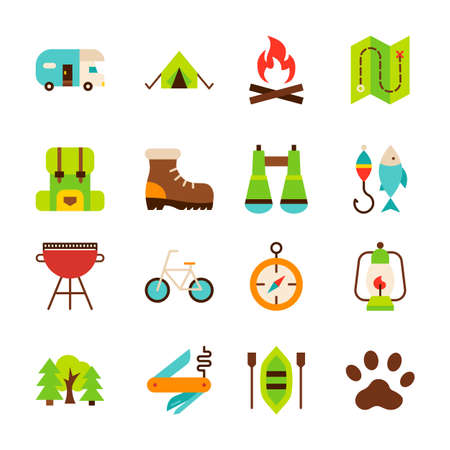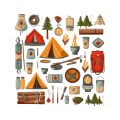1. Solar-Powered Camping Gear
As more campers aim to go green and stay off-grid, solar-powered camping gear has become a game-changer. Whether youre deep in the woods or setting up base at a national park, the sun can now power your essential devices without harming the environment.
Why Go Solar on Your Next Camping Trip?
Solar energy is clean, renewable, and free. Traditional batteries and fuel-based gear not only add weight but also leave behind waste and emissions. With solar-powered tools, you reduce your carbon footprint while enjoying modern comforts outdoors.
Popular Solar-Powered Camping Gear
| Gear Type | Description | Eco-Friendly Benefit |
|---|---|---|
| Solar Lanterns | Rechargeable lights powered by sunlight, perfect for nighttime visibility. | Eliminates disposable batteries and reduces light pollution. |
| Solar Cookers | Use concentrated sunlight to cook meals without fire or gas. | No smoke emissions or fuel needed—clean cooking every time. |
| Solar Chargers | Keep phones, GPS units, and other devices charged using foldable solar panels. | Cuts down on generator use and keeps electronics running sustainably. |
How It Helps You Stay Off-Grid
Solar gear means less reliance on campsites with electrical hookups. You can explore remote areas with confidence, knowing your essentials will stay powered through the day. Many modern solar chargers even come with battery storage, so you can charge up during daylight and use power at night.
Pro Tip:
Look for multi-functional solar gear—like lanterns that double as phone chargers—to save space and pack lighter without sacrificing functionality.
Whether youre weekend camping or on a week-long backcountry adventure, solar-powered gear lets you experience nature while protecting it for future generations.
2. Eco-Friendly Camping Tents and Materials
As more outdoor lovers look to reduce their impact on the planet, eco-friendly camping gear is becoming a big trend in 2025. One of the biggest changes? The materials used in tents and other outdoor essentials. Today’s green camping tents go beyond just being lightweight and waterproof—theyre made from biodegradable, recycled, and sustainably-sourced materials that are designed to leave no trace.
Biodegradable Tent Fabrics
Some companies are now offering tents made with biodegradable materials such as hemp canvas or bio-based polyester. These fabrics break down naturally over time, especially when disposed of properly. Theyre strong enough to handle the elements but gentle on the Earth.
Recycled Materials
Recycled plastics and post-consumer waste are being transformed into durable tent fabrics, poles, and zippers. Not only does this help reduce landfill waste, but it also gives new life to old materials. Here’s a quick look at common recycled materials found in today’s eco tents:
| Material | Source | Used For |
|---|---|---|
| Recycled PET (rPET) | Plastic bottles | Tent fabric, rainfly |
| Recycled aluminum | Cans & scrap metal | Tent poles |
| Recycled nylon | Old fishing nets & textiles | Zippers, tent floors |
Sustainably-Sourced Components
In addition to using recycled content, some tents now include parts made from responsibly harvested wood or bamboo for stakes and support structures. These renewable resources grow quickly and have a lower carbon footprint compared to traditional metal or plastic parts.
What to Look for When Shopping Green Tents:
- Certifications: Look for labels like GRS (Global Recycle Standard) or Bluesign® for sustainable production practices.
- Repairability: Choose tents with modular parts that can be easily replaced instead of throwing the whole tent away.
- PFC-Free Coatings: Avoid tents treated with harmful chemicals like perfluorinated compounds (PFCs) which pollute water sources.
The future of camping is all about blending comfort with responsibility. By choosing eco-friendly tents made with better materials, you’re helping protect the great outdoors for years to come.

3. Portable Water Filtration Systems
When youre deep in the backcountry, having access to clean drinking water is a must. In 2025, portable water filtration systems have become smarter, lighter, and more eco-friendly than ever before. These devices allow campers to safely drink from streams, lakes, and even puddles—without relying on harsh chemicals or bulky gear.
Why Go Chemical-Free?
Traditional water purification often involves iodine tablets or chlorine drops. While effective, these methods can leave an unpleasant taste and arent great for the environment. Newer filtration technologies use physical barriers like hollow fiber membranes or activated carbon to remove bacteria, protozoa, and even microplastics—without adding anything harmful to nature.
Top Features to Look For
When shopping for a green portable water filter, consider the following:
| Feature | Why It Matters |
|---|---|
| No Chemicals | Safer for your body and better for the environment |
| Lightweight & Compact | Easy to pack and carry on long hikes |
| Reusable Filters | Reduces waste and saves money over time |
| Fast Flow Rate | Makes it quicker to fill bottles or hydration bladders |
| Removes Microplastics | Addresses a growing concern in natural water sources |
Popular Eco-Friendly Options in 2025
This year’s market has seen a rise in ultra-portable filters that screw directly onto standard water bottles or come built into collapsible pouches. Brands like LifeStraw, GRAYL, and Sawyer continue to innovate with models that require no batteries or charging—just fill and sip.
Pro Tip:
If you’re planning a multi-day trip, choose a system that can filter at least 1,000 liters before needing a replacement. That way, you’ll stay hydrated without creating unnecessary waste.
4. Electric and Hybrid RV Innovations
If youre dreaming of hitting the open road while keeping your carbon footprint low, electric and hybrid RVs are changing the game in 2025. These next-gen recreational vehicles are designed to provide the comfort of traditional RVs with cleaner, more efficient energy solutions. Whether you’re exploring national parks or camping off-grid, EV and hybrid RVs offer a sustainable way to enjoy the outdoors without sacrificing modern amenities.
Why EV and Hybrid RVs Matter
Traditional RVs run on gasoline or diesel, which can produce a lot of emissions during long trips. In contrast, electric and hybrid models use batteries or a mix of battery and fuel power to reduce greenhouse gas output. This means less pollution at campsites and fewer stops at gas stations.
Main Benefits:
| Feature | Electric/Hybrid RVs | Traditional RVs |
|---|---|---|
| Emissions | Low to zero | High |
| Fuel Costs | Lower (or none) | Higher |
| Noisy Engine | Quiet operation | Loud engine sounds |
| Sustainability | Eco-friendly tech | Conventional fuel use |
The Latest Models in 2025
This year, several brands have rolled out impressive electric and hybrid RV options. Companies like Winnebago, Airstream, and Thor Motor Coach are leading the charge with models that feature all-electric drivetrains, solar charging capabilities, and smart energy management systems.
A Few Highlights:
- Winnebago eRV2: All-electric van with solar panels and zero tailpipe emissions.
- Airstream eStream: Electric-powered trailer that can drive itself into position at your campsite.
- Thor Vision Vehicle: Hybrid motorhome with an advanced digital cockpit and extended range.
Campsite Compatibility
Campsites across the U.S. are quickly adapting to support this green shift. Many now offer EV charging stations, especially near popular national parks and eco-tourism destinations. Plug-in options make it easy to recharge your vehicle while enjoying nature.
Tips for EV Camping:
- Plan routes based on charging station availability.
- Campsites with solar hookups can extend your off-grid time.
- Packing lighter helps conserve battery power during travel.
The rise of electric and hybrid RVs is making it easier than ever to enjoy road trips without harming the environment. Whether you’re a weekend warrior or a full-time RVer, these innovations are paving the way for greener adventures in 2025.
5. Zero-Waste Cooking Solutions
Cooking outdoors doesn’t have to mean creating waste or relying on single-use items. In 2025, zero-waste cooking solutions are making it easier than ever for campers to enjoy delicious meals without leaving a trace. These eco-conscious tools and techniques help reduce your environmental footprint while keeping things practical and portable.
Eco-Friendly Campfire Alternatives
Traditional campfires can be inefficient and release pollutants. Modern biomass stoves are changing the game by using renewable materials like twigs, pinecones, or wood pellets to generate clean-burning heat. These stoves are compact, smokeless, and don’t require propane or other fossil fuels.
| Stove Type | Fuel Source | Eco Benefits |
|---|---|---|
| Biomass Stove | Twigs/Wood Pellets | No gas needed, low emissions |
| Solar Cooker | Sunlight | Zero fuel use, no smoke |
| Alcohol Stove | Ethanol/Methylated Spirits | Clean burn, minimal residue |
Compostable & Reusable Utensils
Say goodbye to plastic forks and paper plates. Compostable utensils made from bamboo, cornstarch, or even edible materials are now widely available. For long-term camping enthusiasts, investing in stainless steel or silicone cookware that lasts for years is both eco-friendly and wallet-friendly.
Utensil Options Comparison
| Material | Reusable? | Compostable? |
|---|---|---|
| Bamboo | No (single-use) | Yes (home compostable) |
| Cornstarch Bioplastic | No (limited reuse) | Yes (commercial composting) |
| Stainless Steel | Yes (long-lasting) | No |
| Silicone | Yes (durable) | No (but recyclable) |
Sustainable Food Storage & Prep Gear
Ditch plastic wrap and zip bags for beeswax wraps, silicone pouches, and collapsible containers. They’re reusable, lightweight, and perfect for organizing ingredients without the waste.
Quick Tips for Zero-Waste Meal Prep:
- Pre-chop veggies at home and store in reusable containers.
- Avoid canned goods—opt for dried or fresh foods instead.
- If you pack it in, pack it out—always bring a trash bag for any unavoidable waste.
The right gear makes it easy to cook sustainably while enjoying the great outdoors. With these zero-waste cooking technologies, you can prepare hearty meals that nourish both you and the planet.
6. Smart Tech for Leave-No-Trace Camping
In 2025, camping responsibly is easier than ever thanks to smart technology that helps outdoor lovers minimize their environmental impact. From mobile apps to high-tech gear, these tools are designed to support the Leave No Trace (LNT) principles—helping you enjoy nature while preserving it for others.
Helpful Mobile Apps
Several mobile apps are now available to guide campers in following eco-friendly practices. These apps provide real-time information on trail conditions, weather updates, and even wildlife activity to help you plan low-impact trips. Some of the most popular LNT-focused apps include:
| App Name | Main Features |
|---|---|
| LNT.org App | Leave No Trace guidelines, campsite locator, impact tracker |
| Gaia GPS | Offline maps, trail planning, eco-friendly route suggestions |
| Seek by iNaturalist | Plant and animal ID for responsible interaction with nature |
Sensors That Track Your Impact
Wearable sensors and smart campsite monitors are making it easier to understand your footprint. Some products can measure air quality around your campfire or detect soil compaction levels at your tent site. These insights help you adjust behaviors in real time to reduce damage to natural areas.
Smart Equipment for Eco-Conscious Campers
Camping gear has gone high-tech too. There are solar-powered cooking devices that eliminate the need for firewood, and biodegradable waste sensors that alert you when its time to pack out trash. Heres a quick look at some innovative options:
| Gear | Sustainable Feature |
|---|---|
| Solar Cooking Stoves (e.g., GoSun Fusion) | No fuel needed, zero emissions cooking |
| Smart Trash Canisters (e.g., Outland SmartBin) | Sends alerts when full; encourages proper disposal |
| Portable Air Quality Monitors (e.g., Atmotube Pro) | Measures pollution levels from campfires or stoves |
The Future of Low-Impact Camping
By embracing these smart technologies, campers in 2025 can stay informed and make better decisions outdoors. Whether youre a weekend warrior or a backcountry explorer, tech tools make it simple to leave no trace and enjoy nature responsibly.


